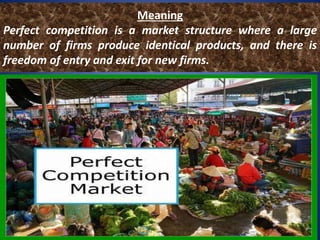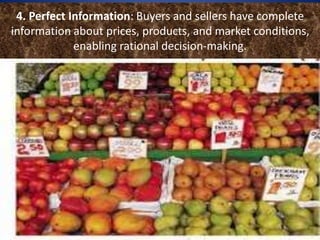INTRODUCTION TO MICRO ECONOMICS Dr. R. KURINJI MALAR
- 1. PG & RESEARCH DEPARTMENT OF ECONOMICS SACRED HEART COLLEGE (AUTONOMOUS) TIRUPATTUR - 635 601 BY Dr. R. KURINJI MALAR ASSISTANT PROFESSOR PG & RESEARCH DEPARTMENT OF ECONOMICS SACRED HEART COLLEGE (AUTONOMOUS) TIRUPATTUR 635 601
- 2. MICRO ECONOMICS-II SYLLABUS II BA ECONOMICS UNIT I PERFECT COMPETITION Features- equilibrium of firm and industry - Perfect vs Pure Competition - Pricing under Perfect Competition under Short run and Long run - Importance of time element in price theory.
- 3. Meaning Perfect competition is a market structure where a large number of firms produce identical products, and there is freedom of entry and exit for new firms.
- 4. Features 1. Homogeneous Products: All firms sell identical products, meaning consumers perceive no difference between products from different producers.
- 5. 2. Free Entry and Exit: New firms can enter the market easily if profits are being made, and firms can exit if they are experiencing losses.
- 6. 3. Many Buyers and Sellers: There are numerous buyers and sellers in the market, none of whom have market power to influence the price.
- 7. 4. Perfect Information: Buyers and sellers have complete information about prices, products, and market conditions, enabling rational decision-making.
- 8. 5. Low Barriers to Entry and Exit: There are minimal barriers preventing new firms from entering the market or existing firms from leaving. This ensures that profits are driven towards normal levels in the long run.
- 9. 6. Perfect Mobility of Factors of Production: Factors of production (such as labor and capital) can move freely between different industries or uses, ensuring efficient allocation of resources.
- 10. 7. No Market Power: Individual firms have no control over the market price and are price takers, meaning they accept the market-determined price for their product.
- 11. 8. Absence of Externalities: There are no external costs or benefits imposed on third parties outside the transaction between buyers and sellers. This helps in achieving allocative efficiency.
- 12. 9. Uniformity in Product Quality: Products offered by different firms are of uniform quality and specifications, ensuring that consumers can make purchasing decisions solely based on price.
- 13. 10. Profit Maximization: Firms aim to maximize profits in the short run by producing where marginal cost equals marginal revenue, and in the long run where marginal cost equals price.












